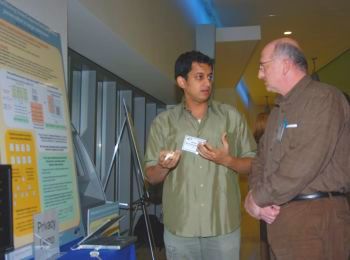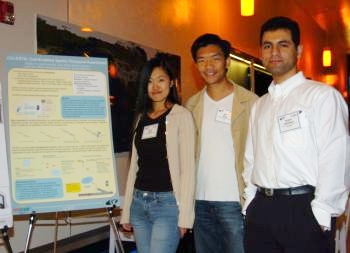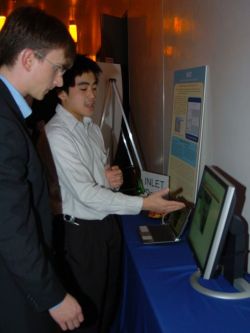RESCUE Project Poster Session, Demonstrations Draw A Crowd
|
San Diego, CA, January 11, 2006 -- More than 100 people attended a poster session and reception given to highlight current and ongoing research of the RESCUE (Responding to Crises and Unexpected Events) Project on Monday, January 9. RESCUE personnel and affiliates attending this year's RESCUE All-Hands Meeting were joined by more than 40 guests, including community members, industry partners, researchers from across the UCSD campus and other interested parties.
The goal of the RESCUE project is to radically transform the ability of responding organizations to gather, manage, use, and disseminate information within emergency response networks and to the general public.
The event was part of the annual RESCUE All-Hands Meeting, which was held in Atkinson Hall (the new UCSD Calit2 building) Monday and Tuesday. The meeting itself was invitation-only. The poster session and demonstrations which were open to the public, provided guests with an opportunity to learn about the depth and breadth of the research activities of the RESCUE Project, as well as meet some of the researchers involved.
The enthusiastic crowd enjoyed the 31 posters and demonstrations; a few of the demonstrations are highlighted here. An announcement will be made when the PDFs of the posters will be available online.
|
~ Situational awareness (SA) applications monitor the real world in order to support tasks such as rapid decision-making, reasoning and analysis. The quality of response activities that occur as a disaster unfolds are decision-centric. These decisions depend directly on the information - situational awareness - available. Awareness of a situation, which includes information about people (their vulnerabilities, location, demographics), resources (food, water, shelter), the progression of the event, related activities and other factors, is among the most important factors influencing the quality of decisions and hence, the appropriateness and efficacy of the response. The goal of the Situational Awareness from Multimodal Input (SAMI) project group is to design and develop general-purpose tools and technologies which can create actionable situational awareness out of the avalanche of heterogeneous multi-modal data streams (audio, speech, text, video, etc.) including human-generated input (e.g., first responders’ communications, field reports, etc.) during or after a disaster. Naveen Ashish presented an integrated demonstration showing the achievement of situational awareness given a set of emergency (911 calls) events in Santa Cruz, CA. Capabilities in speech recognition information extraction, disambiguation analysis and GIS were demonstrated. ~~ SAMI - From Raw Information to Situational Awareness: Stella Chen, Ram Hariharan, Yiming Ma, Dawit Seid, Naveen Ashish, Ramesh Jain, Sharad Mehrotra and Nalini Venkatasubramanian.
~ CalMesh was the focus of a demonstration. CalMesh is an ad-hoc network of small, lightweight, and easily configurable nodes which quickly self-organize to form a reliable wireless mesh network. It is designed for rapid deployment at the site of a crisis to restore communications crucial to the emergency response. It has been used in San Diego Metropolitan Medial Strike Team (MMST) drills, most recently in mid-November. Cal-Mesh nodes are battery operated wireless relaying devices using standard IEEE 802.11b-based WiFi technology, which enables easy set up during emergencies. The CalMesh nodes are developed in-house at the UCSD Division of CalIT2. They are funded by the Responsphere project which is an infrastructure project associated with RESCUE. ~~ CalMesh: B. S. Manoj, Rajesh Mishra, Brian Braunstein, Javier Rodriguez Molina, Boz Kamyabi, Don Kimball and Troy Trimble.
|
~ Michael Mio of ImageCat, subcontracting investigators on the RESCUE project and Calit2 industry partners who specialize in risk management technologies, presented INLET. INLET is a web-based loss estimation and transportation simulation platform that is used to quantify the efficacy of Information Technology (IT) solutions in reducing the impact of disasters on transportation systems. INLET combines a GIS component, a risk modeling platform and a transportation model to provide online estimates of transportation system impacts, building damage and casualties from earthquakes. A simulation component to model the effects of IT on evacuation routing was demonstrated. The model illustrated how awareness of a disaster scenario anywhere in a region and familiarity with routing alternatives can reduce traffic congestion and evacuation times. ~~ INLET: R.T. Eguchi (PI), C.K. Huyck, H. Chung, M. Mio and S. Cho.
Media Contacts
by Maureen C. Curran <mcurran |at| ucsd.edu>
Photos by Barbara Haynor
Related Links
Situational Awareness from Multimodal Input (SAMI)
ImageCat, Inc.
Related Projects
Responding to Crises and Unexpected Events




